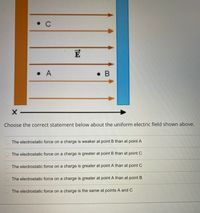Question

Transcribed Image Text:• C
E
• A
• B
Choose the correct statement below about the uniform electric field shown above.
O The electrostatic force on a charge is weaker at point B than at point A
The electrostatic force on a charge is greater at point B than at point C
The electrostatic force on a charge is greater at point A than at point C
The electrostatic force on a charge is greater at point A than at point B
The electrostatic force on a charge is the same at points A and C
Expert Solution
This question has been solved!
Explore an expertly crafted, step-by-step solution for a thorough understanding of key concepts.
Step by stepSolved in 2 steps

Knowledge Booster
Similar questions
- A system consists of two charges of equal magnitude and opposite sign separated by a distance d. Since the total electric charge of this system is zero, can we conclude that the electric field produced by the system is also zero? Does your answer depend on the separation d? Explain.arrow_forwardTwo charges q1 = +3e and q2 = +5e are separated by a distance r = R. If they are then separated by a distance r = 2R, by how much would you need to change the charges q1 and q2 so that they exert the same force on each other as in the original configuration? There are three possible values for each chargearrow_forwardA point charge ?1 with a charge 2.0 X 10−6 C is initially at rest at a distance of 0.25 m from second charge ?2 with a charge 8.0 X 10−6 C and mass 4.0 X 10−9 kg. Both charges are positive. Charge ?1 remains fixed at the origin, whereas ?2 travels to the right upon release. a) Determine the speed of charge ?2 when it reaches a distance of 0.50 m from ?1 Diagram posted below.arrow_forward
- Two point charges are placed on the x axis. (Figure 1)The first charge, q = 8.00 nC, is placed a distance 16.0 m from the origin along the positive x axis; the second charge, 92 = 6.00 nC , is placed a distance 9.00 m from the origin along the negative x axis. Calculate the electric field at point A, located at coordinates (0 m, 12.0 m ). Give the x and y components of the electric field as an ordered pair. Express your answer in newtons per coulomb to three significant figures. • View Available Hint(s) EAz, EAy = 0,0.300 N/C Submit Previous Answers v Correct igure < 1 of 1 Part B An unknown additional charge q3 is now placed at point B, located at coordinates (0 m, 15.0 m ). Find the magnitude and sign of q3 needed to make the total electric field at point A equal to zero. В (0 m, 15 m) А (0 m, 12 m) Express your answer in nanocoulombs to three significant figures. • View Available Hint(s) O (0 m, 0 m) 92 (-9 m, 0 m) 91 (+ 16 m, 0 m) ΠνΠ ΑΣφ 93 = nCarrow_forwardneed within 1 hrarrow_forwardA pair of unlike charges equal in magnitude and separated by a small distance is known as a dipole. Such a pair is situated on the x axis at equal distances from the origin as shown in the figure below. Use the direction rosette to answer the questions. ΧΑ 8 + * D E B 3 +q -9 5 9 zero magnitude (a) What is the direction of the net electric field at location C due to both charges? 5 X Did you consider the symmetry of the situation? What is the net contribution to the field from the y components of the field from each charge? (b) What is the direction of the net electric field at location D due to both charges? ---Select--- v (c) What is the direction of the net electric field at location E due to both charges? ---Select--- ✓ Additional Materials Reading 7arrow_forward
- Three point charges are located on the positive x-axis of a coordinate system Charge g = 15 nC as 20 cm from the origin, charge 40 nC is 4.0 cm from the origin and charge q = 60 nC located at the ongin For related problem-solving tips and strategies, you may want to view a Video Tutor Solution of Vector addition of electric forces on a line 4 Y Part A What is the magnitude of the net force exerted by the other two charges on charge g150 Express your answer in newtons ΑΣΦ 1- Submit Part B 0= Request Answer Submit What is the direction of the net force exerted by the other two charges on charge 15 aC Express your answer in degrees. ΘΕΙ ΑΣΦΑ ? Request Answer N ? counterclockwise from the directionarrow_forwardHow many of the following statements about the electrostatic force (Coulomb's Law) are true? • The strength of the electrostatic force between two charges increases with the square of the distance between them • The strength of the electrostatic force between two charges decreases with the masses of the two charges • The strength of the electrostatic force between two charges is zero in vacuum • The charges must be in motion to experience an electrostatic force Two statements only O Three statements only One statement only O No statement is true All four statementsarrow_forward
arrow_back_ios
arrow_forward_ios